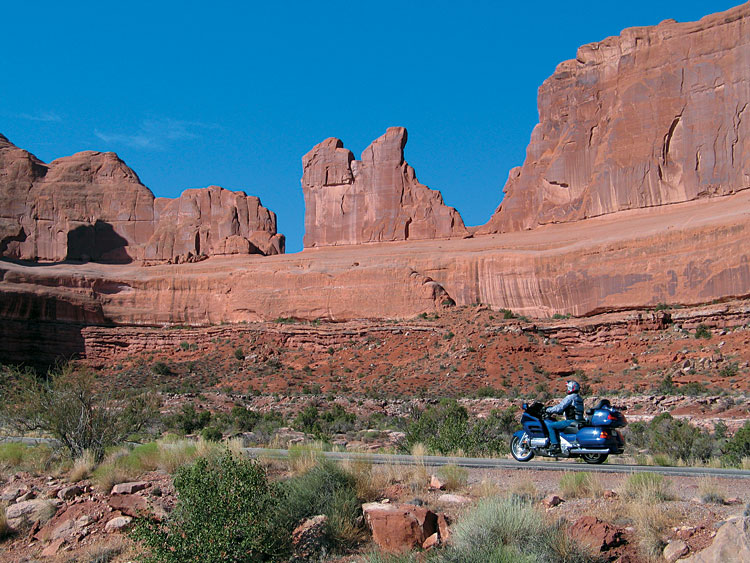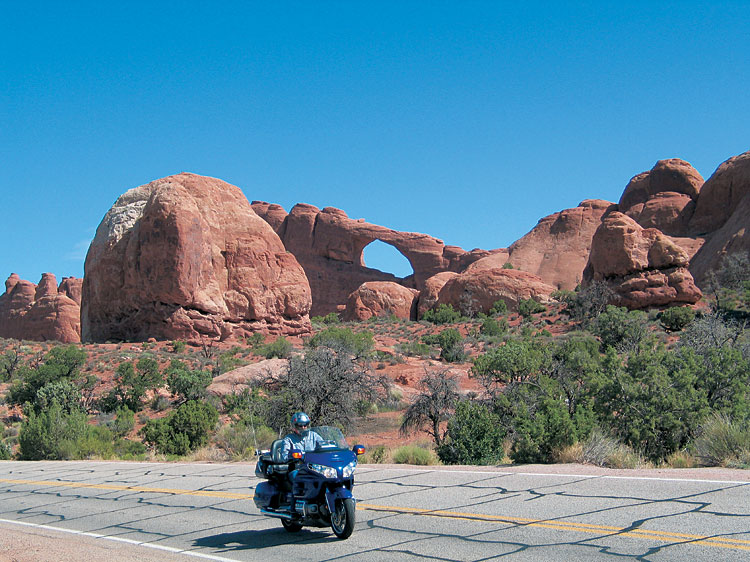Classic Roads: Highway 191 - Utah

As the remaining miles of Arizona's claim to Highway 191 dwindle to single digits, we look back on all we've seen. From its cool, high-mountain passes to sweltering, wind-blasted deserts, the Copper State has presented some of the most imposing scenery we've ever encountered in all our travels. A little smile of anticipation and curiosity curls my lips as we breeze past the sign welcoming us to Utah.
We've been riding in the desert for a while and we're ceaselessly amazed by the cavalcade of subtleties that our eyes are finally beginning to comprehend. Nature has graced the indigenous critters with remarkable camouflaging to help them survive this inhospitable environment. The lizards, snakes, and birds that flee the interloping Gold Wing betray their positions only in fleet movements. Muted flashes of sienna and beige scurry, slither, and flit to safer distances, melting into the baking rocks and sand as quickly as they appear. Windswept spires and rock formations change too. Their subdued, ruddy coloration, so prevalent in the morning light, slowly becomes a darkened ocher as the sun journeys across the sky. About the only three things that aren't understated out here are size, loneliness, and incredible beauty.
Motorin' To Moab
The stark landscape suddenly springs to life as Highway 191 drops toward the San Juan River and runs through the small town of Bluff. Much like the Mormon settlers who arrived back in 1880, we find this welcoming, green hollow an irresistible place to stop. Enormous sand-colored boulders and steep cliffs making up the river valley's northern wall dominate the town's well-preserved Old West buildings. Several small cafes turn Bluff into a very appealing place to park for lunch, but still hanging on to breakfast, we decide to push on. Leaving town, the road begins a short, but entertaining climb from the valley floor, winding around huge rocks and between steep rock faces. The sandstone formations take on otherworldly atmospherics as the sun intermittently peeks between the rocks and precipices, throwing down abrupt shafts of light. It almost feels like we're caught in the blinding cone of brilliance cast by a monstrous spotlight. In the blink of an eye, the lush valley ends and we shoot back out into the desert. As we make our way north, the view slowly begins to change. Though this is still desert terrain, more plant life begins to dot the sides of the road, with dry grasses creeping toward the asphalt and small bursts of green poking through the rocky hillsides in the distance.

In Monticello, we discover that finding a bite to eat on a Sunday can be a challenge. Utah's religious roots run deep and the laws governing the Sabbath are as blue as the big, beautiful sky. And the prospect of finding suds to fill a glass at our stop in Moab are about as likely as hearing a note of worldly optimism from the prophets on the airwaves.
A little further north, we come across a very unique rock formation called Church Rock. At a distance it looks like a giant teakettle was dropped in the middle of the sprawling valley. What's even more peculiar is the manmade cave carved into the base. No trespassing signs, a wide-open field, and a healthy respect for western marksmanship leave me no alternative to ignoring my curiosity and heeding Kathy's advice to move on. Sandstone rocks awash in countless shades of red and pink, scoured to a smooth, sculptured finish by ages of wind and rain, begin to dominate the scenery; and the exposed prehistoric strata within these cliffs and stone spires appears to have been applied by the roller of an over-zealous housepainter with a fondness for muted horizontal stripes. Next, we come upon Wilson Arch, a natural bridge of Entrada sandstone. Over millions of years the softer center of the ridgeline was whittled away by the erosive forces of water, ice, heat, and wind. Eventually, it collapsed, leaving the more stable top, the arch, as we see it today. Located right next to Hwy 191, Wilson Arch is readily accessible and a relatively easy walk is all it takes for closer examinations.

A little farther up the road, nature gets a helping hand from man in a truly classic roadside attraction. Hole N" [sic] The Rock is a 5,000 square-foot, fourteen-room home blasted out of and chiseled into a solid sandstone cliff. Master excavator Albert Christiansen removed 50,000 cubic feet of stone between 1940 and 1952, the year he and his wife Gladys moved into this residential anomaly. Between 1945 and 1955, the couple operated a diner in the Hole. Albert not only did the cooking, he continued his excavating on the side. Albert passed away in 1957 (I'm guessing from exhaustion) and Gladys continued working the Hole N" The Rock as a tourist attraction until her death in 1974. Today the site is open to the public for a small fee and, of course, there's a gift shop featuring everything from the finest examples of local crafts to some of the finest pieces of roadside crapola anywhere.
Nearing Moab, the signs for whitewater rafting, mountain biking, hiking, and four-wheeling begin to proliferate. This part of Utah is a mecca for the outdoor set, and the main drag of this small but trendy town proves it. No matter where you look, backpacks and bicycles dominate. Happily, the Red Stone Inn is within walking distance of just about everything in town.